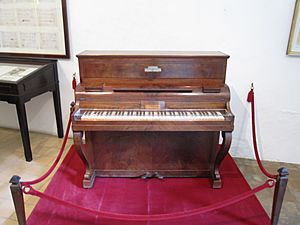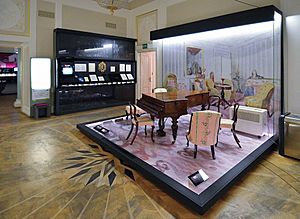Pleyel et Cie facts for kids


Pleyel et Cie. is a famous French company that makes pianos. It was started in 1807 by a composer named Ignace Pleyel. Later, in 1815, his son Camille joined the business. Many famous musicians loved Pleyel pianos. For example, the famous composer Frédéric Chopin thought they were the very best!
Pleyel also had its own concert hall, called the Salle Pleyel. Chopin played his first and last concerts in Paris there. One big invention by Pleyel was using a metal frame inside pianos. This made pianos stronger and sound better. Composers like Chopin, Debussy, and Ravel chose Pleyel pianos.
Contents
History of Pleyel Pianos
Around 1815, Pleyel was the first company in France to introduce the short, vertical upright piano. These pianos were also called "pianinos." They were very popular in Britain and Pleyel adapted the design.
Pleyel pianos became very successful. By 1834, the company had 250 workers. They were making about 1,000 pianos every year!
Cool Piano Inventions
Because they were so successful, Pleyel invested in new ideas. In 1890, they created a "double piano." This instrument had two pianos built into one frame. It was invented by a Hungarian composer named Emánuel Moór.
Pleyel's double piano was called the "Duo-Clave." It was the most successful of its kind. They made a few of these special pianos until the 1920s. You can even find CDs today with music played on these unique instruments!
Towards the end of the 1800s, the Pleyel company also made the first chromatic harp. This was another important musical invention.
In the early 1900s, a musician named Wanda Landowska helped bring back interest in the harpsichord. Pleyel also played a part in this.
Special Pianos for Special Needs
In 1913, Pleyel built a "Jungle Piano" for Albert Schweitzer. He was a doctor and musician working in a hospital in Africa. This piano was made from special tropical woods. It was designed to handle the hot and humid weather there. It even had pedals like an organ!
In the 1920s, Pleyel also made a few "Hans pianos." These had two keyboards, one tuned a half-step higher than the other. They were designed by an engineer named Pierre Hans. However, these pianos were not used much after World War II.
Pleyel also helped create the player piano. These pianos could play music by themselves using special rolls. Pleyel called their line of player pianos "Pleyela."
Pleyel Pianos Today
Pleyel continued making pianos until 2013. For a while, they were part of the French Piano Manufacturing Company. In the 1980s, Pleyel bought other French piano companies like Erard and Gaveau. Pleyel pianos today use improvements from these companies.
Later, the family that owned the Salle Pleyel concert hall bought the Pleyel company. They wanted to bring the famous Pleyel name back to life. They built a new factory in the south of France. There, they started making new and improved pianos.
In 2008, they moved the factory back to Paris. They started making new pianos designed by famous artists. The wood for Pleyel pianos, called red spruce, came from the Fiemme Valley in Italy. After a piano was put together, it got 30 to 40 more hours of careful tuning.
At the end of 2013, the company announced it would stop making pianos. But in 2017, a company called Algam bought Pleyel. Algam has invested a lot in the brand. Now, Pleyel pianos are being made again! This makes Pleyel the oldest piano company in the world that is still producing pianos.
2009 Replica Piano
In September 2009, Pleyel made a copy of a Pleyel piano from 1830. This was the type of piano used by Fryderyk Chopin. The original piano is now in the Fryderyk Chopin Institute in Warsaw.
Pleyel used the original piano to create the plans for this new copy. This replica piano was even used in a special competition in 2018. It was called The 1st International Chopin Competition on Period Instruments.
Recordings with Pleyel Pianos
Many musicians have made recordings using original Pleyel pianos or copies of them. This helps us hear what these historical pianos sounded like.
- Yuan Sheng played Frederic Chopin's Ballades and Impromptus on an 1845 Pleyel piano.
- Ronald Brautigam played Felix Mendelssohn's Piano Concertos on a copy of an 1830 Pleyel piano. This copy was made by Paul McNulty.
- Janusz Olejniczak recorded a "Chopin evening" using an 1831 Pleyel piano.
- Alexei Lubimov played music by Chopin, Bach, Mozart, and Beethoven on an original 1843 upright Pleyel piano.
- Dina Yoffe played Fryderyk Chopin's Piano Concertos No 1 & 2 on an 1848 Pleyel and an 1838 Erard piano.
- Viviana Sofronitsky and Sergei Istomin played Chopin's Complete works for cello and piano on a copy of an 1830 Pleyel piano made in 2010 by Paul McNulty.
- Kevin Kenner played Fryderyk Chopin's 4 Impromptus on an 1848 Pleyel piano.
- Tomasz Ritter played Chopin's Sonata in B Minor and other pieces on an 1842 Pleyel piano.
- Kimiko Douglass-Ishizaka played Frederic Chopin's 24 Preludes on an 1842 Pleyel piano.
See also
 In Spanish: Pleyel para niños
In Spanish: Pleyel para niños
- Auguste Wolff, who led the company from 1855 to 1887

